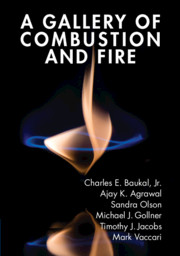Book contents
2 - Computational Fluid Dynamics
Published online by Cambridge University Press: 17 June 2020
Summary
Humans have an insatiable desire to model physical phenomena and to continuously improve those models, be it modeling weather patterns for forecasting, molecular modeling in pharmaceutical research, or even biscuits baking in an oven.1 Of particular interest, especially given the nature of this book, is the modeling of combustion and combustion systems. Modeling of combustion comes in many forms, ranging from simple stoichiometry of global reactions, to detailed kinetic modeling of elementary reactions in a combustion mechanism, to one-dimensional reactor models, to full-blown transient three-dimensional models using Computational Fluid Dynamics (CFD).
- Type
- Chapter
- Information
- A Gallery of Combustion and Fire , pp. 39 - 54Publisher: Cambridge University PressPrint publication year: 2020



